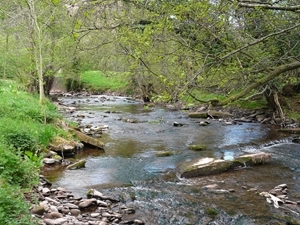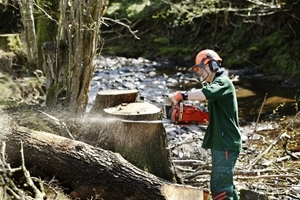 The River Monnow Project began in 2003 as a partnership of national and local bodies led by the Game & Wildlife Conservation Trust (GWCT) and 57% funded by Defra’s England Rural Development Project (ERDP). Other partners were: Monnow Fisheries Association, Wild Trout Trust, Salmon & Trout Association, Grayling Research Trust and Environment Agency (Wales).
The River Monnow Project began in 2003 as a partnership of national and local bodies led by the Game & Wildlife Conservation Trust (GWCT) and 57% funded by Defra’s England Rural Development Project (ERDP). Other partners were: Monnow Fisheries Association, Wild Trout Trust, Salmon & Trout Association, Grayling Research Trust and Environment Agency (Wales).
The aim of the River Monnow Project was to rejuvenate the neglected and damaged river ecologically and as an angling resource. This would benefit the local community through modest job creation, fishing revenues and associated tourism.
In 2003, the Monnow had little or no riverside margin habitat. This was the result of high livestock densities which had increased dramatically in the early 1970s thanks to the economic climate in which farming took place (chiefly the headage-based payments of the CAP and HLCA). River banks were exposed to increasing stock pressure leading to severe and frequent poaching, grazing-out of marginal and bank-side cover, bank erosion and widening of channels. In a similar way, adjacent riparian woodland, bog and rough grazing have been largely lost as a result of increased stock levels.
A concurrent issue was the neglect of riparian tree management. Previously, riverside trees (chiefly alder and willow) had been coppiced for charcoal, clog manufacture and for domestic fuel. Neglected, the dense, uniform stands of mature multi-stemmed alders created intense shade, suppressing in-stream and marginal vegetation and aggravating issues of siltation and erosion. Together, these factors produced denuded actively eroding, friable riverbanks.
 The River Monnow Project built livestock fencing to prevent grazing and trampling within a narrow riverside margin along 68km of river (the entire catchment is 285km), and coppiced riverside trees selectively to let in the light, allowing the regrowth of in-stream and riverside vegetation.
The River Monnow Project built livestock fencing to prevent grazing and trampling within a narrow riverside margin along 68km of river (the entire catchment is 285km), and coppiced riverside trees selectively to let in the light, allowing the regrowth of in-stream and riverside vegetation.
Riparian habitat was much improved by 2006 and at this stage an extension to the project was negotiated in which water voles were reintroduced to the river from captive-bred stock, with simultaneous control of (non-native) mink. This project not only restored lost biodiversity locally, but was also run as a demonstration with national significance.
The River Monnow Project as such ended in 2010. However, that is by no means the end of the story.
The Monnow Fisheries Association – a local membership organisation and one of the original partners of the River Monnow Project – has established a ‘Going Native’ programme to maintain and expand the habitat management begun in 2003-6, and to eradicate invasive species. The MFA draws on a mixture of locally available funding and subscriptions to implement management throughout the catchment, and coordinates angling permits and incomes.
The MFA has also undertaken to coordinate ongoing mink control, with GWCT as an advisory partner.